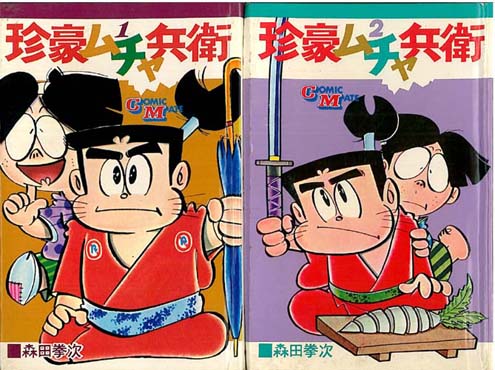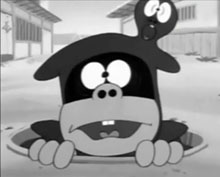
I tackled this anime briefly in my very first post for Cartoon Research, but I felt it warranted a whole post.
Chingo Muchabei has an interesting history in spite of its very short run in television. The 26-episode black and white anime, produced by Tokyo Movie (TMS Entertainment), only aired once on the TBS (Tokyo Broadcasting System) network, for a month and a half in 1971 (February 15 to March 22), on Monday through Friday at 6 PM. But is there more to it than that?
 Like most anime, it was based on a manga. In this case, it was drawn by Kenji Morita (born 1939), who had a few hit series such as Marude Dameo and Robotan. The Chingo Muchabei manga ran on Shonen Magazine for only a year, from 1967 to 1968.
Like most anime, it was based on a manga. In this case, it was drawn by Kenji Morita (born 1939), who had a few hit series such as Marude Dameo and Robotan. The Chingo Muchabei manga ran on Shonen Magazine for only a year, from 1967 to 1968.
The gag-comedy series takes place in the Edo period of Japan. The main character, Muchabei, is a rōnin who makes his living making umbrellas, which is also his primary weapon, not having any swords. He is the sworn protector of Bokemaru, a disinherited prince who is the true heir to the royal Toyotomi family. The current Lord Toyotomi that’s occupying the house is, however, is aware that Bokemaru is still alive, and is intent on getting him snubbed out before he has a chance to overthrow him, thus he entrusted a ninja named Kaburezukin (name literally translates to “Hooded Rash”) to eliminate him. However, he is often thwarted by Muchabei, not to mention the fact that Kaburezukin is a very incompetent ninja.
In spite of the time period it takes place in, anachronism is thrown everywhere, all for laughs. Characters have television sets, street signs are everywhere, and the ninja Kaburezukin is always shown wearing business-style necktie. One can compare this to Fractured Fairy Tales for Japan if inclined.
TMS started producing the 26-episode anime in 1967, the same time they were making another anime called Perman with Studio Zero. Amongst the directors were their regulars Tadao Nagahama, Eiji Okame, and Hiroshi Saito. Animation was handled by A Production, with founder Daikichiro Kusube as the animation director.

However, the show ran into difficulty when it was finally ready for broadcast. By the late 1960s, Japanese television began embracing color shows, so fewer and fewer space were made available for shows done in black and white. As a result, Muchabei kept getting bumped over other shows. In fact, TMS produced two more black and white shows after “Muchabei”: Kaibutsu Kun in 1968, and Umeboshi Denka in 1969. After that, TMS started producing all of their shows in color.
 By the time it finally aired in 1971, four years after its production, it was on a time slot that TBS reserved for repeats of older anime. It’s pretty apparent that the broadcast was to fulfill their contract with the animation studio. The manga itself was already canceled several years prior, as matter of fact. Its broadcast was so quick and swift, one wonders just how many people managed to see it. Because the show’s broadcast was delayed for years, it ended up being the last anime to be shown in black and white.
By the time it finally aired in 1971, four years after its production, it was on a time slot that TBS reserved for repeats of older anime. It’s pretty apparent that the broadcast was to fulfill their contract with the animation studio. The manga itself was already canceled several years prior, as matter of fact. Its broadcast was so quick and swift, one wonders just how many people managed to see it. Because the show’s broadcast was delayed for years, it ended up being the last anime to be shown in black and white.
And because early TV anime are rather spotty when it comes to film preservation, few people had questions about the show’s existence in studio vaults. Those fears were finally laid to rest when the show finally got rerun, on a satellite channel called Home Drama Channel, which reran all 26 episodes in 2009, 38 years after it was last shown on television. Since the show was seemingly remastered, it’s still possible for a DVD set to happen. Whether there’s any interest for this obscure, forgotten but somewhat significant anime, remains to be seen.
Excerpt from the first episode below:


 Charles Brubaker is a cartoonist originally from Japan. In addition to his work for MAD Magazine and SpongeBob Comics, he also created Ask a Cat for GoComics. You can also follow him on his Tumblr page.
Charles Brubaker is a cartoonist originally from Japan. In addition to his work for MAD Magazine and SpongeBob Comics, he also created Ask a Cat for GoComics. You can also follow him on his Tumblr page.











































More interested in Hustle Punch let alone this